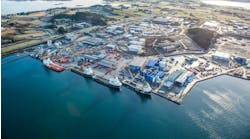Petrobras plans to restart production from Roncador in 2002
HOUSTON, May 1 -- Petroleos Brasileiro SA (Petrobras) plans to restart oil production from Roncador oil field, site of the worst offshore oil industry accident in recent years, in second half 2002.
Petrobras Pres. and CEO Henri Philippe Reichstuhl made the announcement this afternoon at the Offshore Technology Conference while accepting the OTC Distinguished Achievement Award in recognition of the firm's accomplishments in Roncador field development. Petrobras formally dedicated the award to the 11-man firefighting crew who died in the accident.
On Mar. 15, two explosions on the P-36 semisubmersible production platform -- the world's largest of its kind -- crippled the facility, which sank to the seabed in the deepwater field 5 days later.
The Brazilian government has established an independent commission to investigate the accident. Its report covering its major findings has been postponed until mid-June. Last week the commission issued an interim report that fixed the apparent cause of the accident as the ignition of leaked natural gas that had collected in one of the platform support columns (OGJ Online, Apr. 23, 2001). The source of that gas has not been determined.
Restoring production
Petrobras plans to quickly reestablish production at Roncador, which had been producing 84,000 b/d of crude and 1.3 million cu m/day of gas at the time of the accident.
Reichstuhl said plans include the installation of a "provisional" platform to help bridge the gap to full plateau production. Although a decision on what kind of platform has not been made, Reichstuhl indicated it likely would be a leased floating production, storage, and offloading vessel (FPSO) or a conversion of the P-47 floating storage unit (FSO) previously deployed in Roncador into an FPSO. A commercial tender is being prepared, and a decision on the vessel is expected within 15 days, he said.
Petrobras plans to have the provisional platform on stream by September 2002, producing 80,000-90,000 b/d of oil via reentry of five of the existing six Roncador wells and by drilling three new wells. A sixth well was insufficiently productive to warrant reentry. All of the wells were shut in at the time of the accident and were undamaged.
Petrobras plans to make extensive use of existing subsea facilities, including flowlines, that were undamaged in the accident, Reichstuhl said, adding that a remotely operated vehicle deployed immediately after the accident showed minimal damage to subsea facilities.
"We were amazed by the way everything was impeccable in terms of subsea [facilities]," Reichstuhl said.
Petrobras has ordered a new platform to be installed to undertake the second phase of full Roncador development, replacing existing facilities, including the ill-fated P-36. The P-36, installed in 1,360 m of water, was linked with the P-47 FSO. This development layout, dubbed Module 1, was expected to achieve peak production of 180,000 b/d of oil and 7.2 million cu m/day of gas in 2002.
Module 1 will now be replaced by Module 1A, a development plan that calls for drilling 20 producing wells -- 6 of them horizontal -- and 9 water injection wells -- 3 of them horizontal. Module 1A will be split into two phases. The first calls for the installation of the provisional platform for resumption of Roncador production at a rate of 90,000 b/d of oil and 3.2 million cu m/day of gas, with injection of 90,000 b/d of water.
The second phase will consist of a production unit with a process capacity of 180,000 b/d of oil, where 19 planned wells -- including 11 from the first phase -- will be placed on production. This scheme will have the same gas compression and water injection capacity as the first phase.
The second phase production facility is slated to go on stream by January 2004, reaching peak production by 2008. All wells in Module 1A will be connected to the host platform through individual, thermally insulated flowlines to prevent wax buildup and hydrate formation. The new platform will gradually incorporate production from the provisional platform.
In the meantime, Petrobras "has redirected resources [intended for Roncador Module 1] to Marlim Sul" giant oil field, nearby in the Campos basin, Reichstuhl said. Plans now call for increasing production at Marlim Sul by 120,000 b/d. Accordingly, the net oil production loss for Petrobras as a result of the P-36 accident is 60,000 b/d.
Answering critics
Reichstuhl responded to criticism that the accident could have been the result of the speed with which Roncador was developed.
"There is no evidence whatsoever that the [decision to undertake] fast-track [development at Roncador] has anything to do with the accident," Reichstuhl said.
The Petrobras chief also defended his company's safety record in the Campos basin, noting that the P-36 disaster was the only serious accident in the 40-year history of operations in the Campos basin.
Reichstuhl also noted that the P-36 loss was covered by insurance -- although the loss of production wasn't -- and that Petrobras will disclose its analysis of the accident's impact on Roncador development economics at the upcoming annual shareholders' meeting.
Reichstuhl also contends that the P-36 accident was not connected with the pioneering deepwater technologies applied in Roncador field.
A remaining concern is the source of the gas leak that caused the first explosion, which occurred in the starboard aft column of P-36, probably between the third and fourth floors. Among the possible causes of the explosions that the commission is investigating are:
-- A gas leak in the emergency drain tank.
-- A gas leak in the waste oil tank.
-- A gas leak in the turbocompressor on the main deck and ingestion of the gas into the column and pontoon by the ventilation system.
-- A gas leak due to damage to piping.
-- Presence of gas in the bilge system.
-- Return of gas from the vent system.
-- Leaks from diesel tanks.
Because there remains a strong likelihood that the accident may have been caused because of a "link" between gas processing facilities and the platform column, Petrobras is making the investigation of the accident a priority, Reichstuhl said, "because this practice is still being used."


